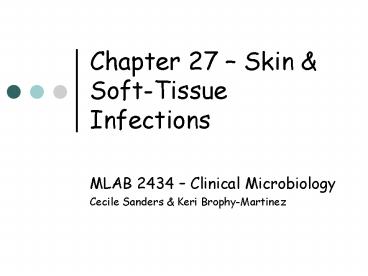Chapter 27 Skin - PowerPoint PPT Presentation
1 / 17
Title:
Chapter 27 Skin
Description:
Erysipelas. Deeper form of cellulitis that infects underlying dermis and ... Cellulitis and erysipelas caused primarily by Streptococcus pyogenes; roughly 10 ... – PowerPoint PPT presentation
Number of Views:53
Avg rating:3.0/5.0
Title: Chapter 27 Skin
1
Chapter 27 Skin Soft-Tissue Infections
- MLAB 2434 Clinical Microbiology
- Cecile Sanders Keri Brophy-Martinez
2
Usual Skin Flora
- Skin flora consists of those microbes able to
adapt to the high salt concentration and drying
effects of the skin - Coagulase-negative Staphylococcus is permanent
resident - Staphylococcus aureus is transient colonizer
3
Usual Skin Flora (contd)
- Diphtheroids
- Propionibacterium acnes
- Corynebacterium xerosis
- Yeasts
- Candida
- Pityrosporum
4
Bacterial Skin Infections
- Primary Pyodermas
- Impetigo
- Most often caused by Streptococcus pyogenes
- Less than 10 caused by S. aureus
- Group B Streptococcus in newborns of infected
mothers - Vesicles rupture, creating a thick, yellow,
encrusted appearance
5
Bacterial Skin Infections (contd)
6
Bacterial Skin Infections (contd)
- Impetigo (contd)
- Lesions are superficial and painless but pruritic
and easily spread by scratching - Bullous impetigo caused by strain of S. aureus
that produces exfoliative toxin
7
Bacterial Skin Infections (contd)
- Impetigo (contd)
- May be complicated by complex-related acute
glomerulonephritis - Folliculitis
- Inflammation infection of hair follicles
- S. aureus most common agent, but P. aeruginosa
implicated from swimming pools and whirlpools
8
Bacterial Skin Infections (contd)
- Folliculitis (contd)
9
Bacterial Skin Infections (contd)
- Furuncles and Carbuncles
10
Bacterial Skin Infections (contd)
- Furuncles and Carbuncles
- Furuncle deep inflammatory nodule
- Carbuncles abscess extending more deeply into
subcutaneous fat and may have multiple draining
sites occur most frequently at nape of neck and
back of thighs - Known as boils
- Most caused by S. aureus
- Most require surgical drainage in addition to
oral, IM, or IV antibiotics
11
Bacterial Skin Infections (contd)
- Cellulitis
- Diffuse inflammation and infection of superficial
skin layers - Localized, mildly painful, swelling with poorly
demarcated margins
12
Bacterial Skin Infections (contd)
- Erysipelas
- Deeper form of cellulitis that infects underlying
dermis and lymphatic channels - Painful, raised, crimson color with sharp
demarcated border
13
Bacterial Skin Infections (contd)
- Cellulitis and erysipelas caused primarily by
Streptococcus pyogenes roughly 10 caused by S.
aureus - Myonecrosis
- Tissue death
- Severe pain, edema, cellulitis, production of
gas, foul-smelling discharge - Clostridial myonecrosis is called gas gangrene
- Most infections are polymicrobial, with mixed
aerobic-anaerobic flora - Flesh-eating disease caused by Group A Strep
14
Bacterial Skin Infections (contd)
- Paronychia
- Infection of the cuticle surrounding the nail bed
- S. aureus is usual cause
15
Secondary Bacterial Skin Infections
- Cutaneous manifestations of systemic bacterial
infections - Some cases of bacteremia will result in various
morphologic rashes or lesions - Virbrio vulnificus
- P. aeruginosa
- S. aureus
- S. pneumoniae
- H. influenzae
16
Secondary Bacterial Skin Infections
- Cutaneous Manifestations from Toxin Production
- Certain organisms are capable of producing toxins
that affect the skin - Stapylococcal Scalded Skin Syndrome
- Toxic Shock Syndrome
- Streptococcal Toxic Shock Syndrome
- Scarlet Fever
17
Laboratory Diagnosis of Skin Soft-Tissue
Infections
- Cultures should be taken from as deep in the
wound as possible to avoid contamination with
skin flora - Direct gram-stain should be performed on all
cultures - If wound exhibits signs of anaerobic organism(s),
the culture must be cultured anaerobically

